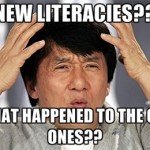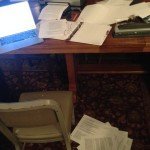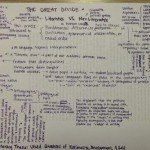
Seneca Schaffer: Moll & Gonzalez “Lessons from Research with Language-Minority Children”
Reading Summary: Lessons from Research with Language-Minority Children
Moll and Gonzalez (1994) use four language minority examples to explore and advocate for utilization of various literacies for accessing knowledge resources and extending beyond the limited, learning boundaries of the “typical” classroom. The author’s first, and ideal, example of such an approach is represented in the intricate, pedagogically innovative, and resource rich Spanish-English bilingual, elementary school in Arizona. Students jump between different linguistic mediums to “accomplish personal, academic, or intellectual tasks” (440). Although likely spruced up by the authors’ wording, students are conducting practices crucial to even higher education. Such examples force me to reflect on my own education in comparison and wonder what the heck I was doing.
The structure of this educational program seems to push students to take advantage of all social, cultural, and literate resources to expand beyond the limitations of the classroom. To encourage broader and more practical knowledge, Moll and Gonzalez explain that it’s necessary to take advantage of the “funds of knowledge” located within local communities.
These “funds of knowledge” are represented in the rich and diverse range of skills and knowledge held by members of the community, ranging from gardening, to mechanical work, to music, to cultural traditions, to medicine, etc. Spurred by a variety of needs/purposes, it was discovered that some innovative students from working class backgrounds picked up mechanical or mercantile skills. In one instance, one parent’s musical abilities were gradually incorporated to improve the educational experience of students. These examples emphasize the “potential that can be harnessed by transcending the boundaries of the school and making inroads into the funds of knowledge of the community” (446).
The second example explores how instructors guided (through questions and discussion facilitation) students use of language to access various sources of knowledge and help them “develop a collaborative approach to science” (446). These resources of knowledge were not only instructors, but also fellow students. Similarly, the third example delves into how instructors facilitated cooperation between students and teachers for research practices. Students were “shown the ropes,” given responsibility and respect of peers to execute an educational, class-external, purposeful task.
The authors’ fourth example takes a look at another, bilingual (English and Navajo), student-centered curriculum aimed at developing “the children’s concept and problem-solving abilities in the context of culturally salient experiences and topics, while promoting competency in Navajo and English” (450). Through the bilingual approach of inquiry-based tasks, “it allowed children, through their own interactions and explorations to use their knowledge to solve new problems” (450). Through this culturally integrated and learning-active approach, researchers were able to more effectively encourage multiple literacies and respect learners’ identities.
The authors assert that “none of these innovations will last unless teachers are able to overcome the intellectual limits of traditional schooling for these children” (451). Teachers and students need to go beyond the walls of the classroom, take advantage of various “inside” (imagined) and “outside,” (real) knowledge resources and create innovative, practical and meaningful ways (like projects) to apply them (452). With these wide arrays of literacies, language minorities need to be seen possessing assets, rather than deficiencies. Their backgrounds should be acknowledged, respected and incorporated into the learning process if we intend to improve the effectiveness of education.
Personal Thoughts
Even with English as the lingua franca of the world, the U.S. will gradually learn how much it’s missing out on economically, and personally by not becoming better acquainted with the rest of the world, its languages and associated cultures.
In particular, the authors emphasize this approach for the “working class,” but I can’t help but feel that this approach should be seriously considered for all socio-economic and educational levels. Perhaps the authors were implying that those of a higher ‘class,’ receive or have access to such resources and “working-class” do not, or those on the ‘upper’ scale either receive it and/or have such entitlements later that such skills aren’t necessary later in students’ futures.
While I agree with the advocation of the authors, I can’t help but think that this dated mentality should now be pretty common in education, even though there are not as many funded programs exercising this ideal. As someone who is more pedagogically focused, I agree with the authors’ viewpoint, but I can’t help but feel it’s necessary to express how groundbreaking but demanding such a program would be for educational institutions, their instructors, students, and parents. To support the demands of such a program, participation of the local community would be essential in promoting its success.
I’m all for the innovation of educational approaches, “mainstream” and for language minorities, but the mere fact that we are having these conversations about learning forces me to ask: have we have become so embedded with pedagogically time and cost efficient practices of standardized education that we’re so distanced from the actual purpose of education and diverse, equally beneficial (if not potentially better) alternative approaches to facilitating purposeful and fulfilling learning? Should we not then be directing bigger questions toward our educational system?




